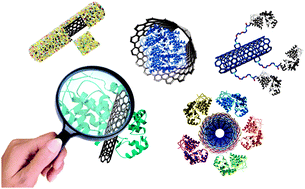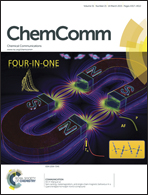Under the lens: carbon nanotube and protein interaction at the nanoscale
Abstract
The combination of the very different chemical natures of carbon nanotubes (CNTs) and proteins gives rise to systems with unprecedented performance, thanks to a rich pool of very diverse chemical, electronic, catalytic and biological properties. Here we review recent advances in the field, including innovative and imaginative aspects from a nanoscale point of view. The tubular nature of CNTs allows for internal protein encapsulation, and also for their external coating by protein cages, affording bottom-up ordering of molecules in hierarchical structures. To achieve such complex systems it is imperative to master the intermolecular forces between CNTs and proteins, including geometry effects (e.g. CNT diameter and curvature) and how they translate into changes in the local environment (e.g. water entropy). The type of interaction between proteins and CNTs has important consequences for the preservation of their structure and, in turn, function. This key aspect cannot be neglected during the design of their conjugation, be it covalent, non-covalent, or based on a combination of both methods. The review concludes with a brief discussion of the very many applications intended for CNT–protein systems that go across various fields of science, from industrial biocatalysis to nanomedicine, from innovative materials to biotechnological tools in molecular biology research.


 Please wait while we load your content...
Please wait while we load your content...